Above: L to R: Hans-Olav Høidahl, Circle K, Norway; Frank Ellingjord-Dale, NorgesGruppen; Brian Donaldson, Maxol Group; and Mark Wohltmann, NACS
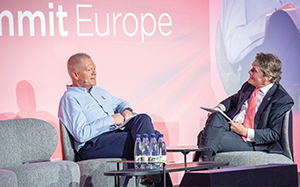 L to R: Jesper Østergaard, Reitan Denmark; and Henry Armour, NACS
L to R: Jesper Østergaard, Reitan Denmark; and Henry Armour, NACS
NACS Convenience Summit Europe brought together convenience retailers and supplier partners from across the globe in Berlin May 31–June 2 to explore top-of-mind issues in the industry and envision the future of everything from unmanned c-stores to ESG to autonomous vehicles.
“What we try to do at NACS is to create a global radar screen for our most progressive members to look into the future and how it’s going to evolve, so that they can be first to market,” NACS President and CEO Henry Armour said, explaining why NACS is engaged on the global stage. “It’s the exploration, the discovery that makes us all smarter.”
Clearly, the future of convenience retail is already here in the form of migrolino AG, owned by the migros group, Switzerland’s largest retailer and operator of 347 convenience stores. Sebastian Becker, head of wholesale and logistics, migrolino, presented “Unmanned, Delivery, Click and Collect, Drive-Thru…We Have It All!”
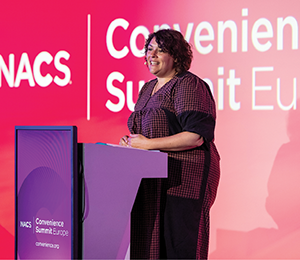 Rebekah Duncalfe, Meraki Creative Therapies
Rebekah Duncalfe, Meraki Creative Therapies
migrolino takes a digital-forward approach, focusing on its mobile app and contactless shopping and payment functionality. Ultra-fresh food sourced locally, better-for-you products, sustainability and efforts to reduce food waste are all key facets of its business model. Under its growth strategy through 2024, migrolino is leaning into foodvenience; digitalization of signage, price labeling, ordering and payments; 24/7 automated format stores, home delivery and location expansion, Becker shared.
Quick commerce is the next retail revolution, Becker noted as he revealed some key performance indicators for heymigrolino, an online shop launched in January 2021 featuring more than 750 items available for delivery in the greater Zurich area. The average basket size for home delivery is 56.45 Swiss francs (US$58.36), nearly six times larger than in-store shopping, and orders are delivered within 36 minutes.
To continue to grow, migrolino developed gooods, a small-format store concept created by women for women, Becker said. It focuses on six megatrends in retail:
- Connectivity: Omnichannel retail
- Fast-moving: Short customer dwell times in the store and impulse buys
- Neo-ecology: Sustainability, zero waste, organic products and animal welfare
- Health: Healthy lifestyles and specialty diets like gluten-free, lactose-free and moral-focused nutrition
- New Work: Work from home and hybrid work arrangements
- Mobility: 24/7 society using new forms of transportation
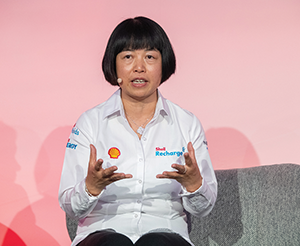 Carol Chen, Shell Global Mobility
Carol Chen, Shell Global Mobility
The tiny stores feature private-label beverages, packaged and ready-to-eat foods. Shelves have electronic labels to reduce labor time, and digital signage enables dynamic customer targeting and scrolling messaging that can be customized according to daypart and store-specific information. Customers can get discounts via the mobile app and can use it to scan their purchases, pay and go, skipping any lines. There’s an online gooods delivery feature, too, offering delivery within 60 minutes. And in-store shoppers can catch up on emails in a workspace since migrolino listened to public transportation officials and included table space for commuters.
Becker said 60% of gooods shoppers are women. “We still sell more chocolate bars than protein bars,” he said. What you won’t find is an emphasis on tobacco. Instead, there is a tobacco vending machine.
The newest concept from migrolino is pick-me 24/7, which the company launched in response to an EV charging partnership with Tesla. “They wanted a shop open 24/7. We said, we can’t have a manned shop at this location, so this was our solution,” Becker said of the automated kiosk-like store in a shipping container.
THE CONVENIENCE OFFER
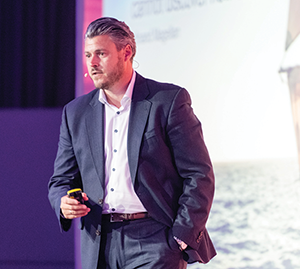 Sebastian Becker, migrolino
Sebastian Becker, migrolino
Nordal Cavadini, partner, Oliver Wyman, presented “The Future Dimensions of the Convenience Offer.” Generation Z is all about digital and immediacy, he shared, outlining what future retailing might entail for a cohort of consumers who have always interacted with screens via touch or voice.
“In 10-15 years from now, the future shopper will make decisions in a much more conscious way, sustainable way, than has been the case in the past,” Cavadini said. “It will be a shopper who makes no compromises in terms of convenience. It will be everything and anything within the hour. ... Mainly shopping online, including for food. And it will be a shopper who takes inspiration from social media, much more than paper or other channels. Likely less driving and perhaps not needing a car. And less cash—everything will be paid for with plastic or a digital wallet.”
The industry is already seeing these shifts. “City center locations are suffering” due to work from home, while suburban locations where people already live “are overindexing.” At-home consumption of meals will continue, although “eating at home does not mean cooking at home,” he said, pointing to delivery of ready-to-eat, ready-to-cook foods. “This part of convenience is picking up massively.”
It has never been as easy as today for the shopper to get food and never as difficult for us as a company to serve all of these touchpoints.
Meanwhile, inflation and higher prices are spurring consumers to shop around and switch to more budget-friendly products. “We have never experienced the level of inflation that we are seeing in 40 years. Depending on where you live in Europe or the U.S., inflation is somewhere between 5 and 10%.”
He noted that “after two years of the pandemic, shoppers want to spend money on other things besides food and mobility. We are selling a bit of food, a bit of tobacco, perhaps some newspapers, and we have a lot of competition with respect to where the future is going to be, which is food for most of us. We are competing for the share of stomach that will make us attractive to a new generation of customers who may not want to stop at a gas station to refuel or even meet that need. It has never been as easy as today for the shopper to get food and never as difficult for us as a company to serve all of these touchpoints.”
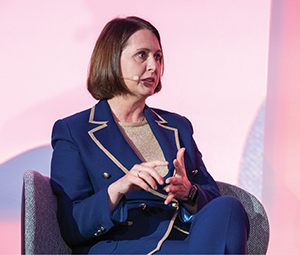 Anna Grabowska, Żabka
Anna Grabowska, Żabka
So, what is a convenience retailer’s role going forward? “First and foremost,” he said, “The store is by no way dead. The majority of consumers are omnichannel—they look online and buy in store or look in store for inspiration and buy online. You want to play a role in the future, you have to be omnichannel.”
Pay attention to direct-to-consumer commerce, he advised. “Your role has to be to control or at least be aware of the different touchpoints taking place” between manufacturers and retailers and consumers.
His third piece of advice for retailers is to consider partnerships with established players. “Think about coming together with those who have more experience in covering parts of the value chain that are new. He shared what he calls six archetypes for success. These include: product leadership (own labels, superior offers), magnetic platform (ecosystem that locks consumers in for all purchases), go-to-choice intermediary (digital influences), customer experience, proximity player (food is an important touchpoint to drive frequency and basket size) and fulfilment intermediary (delivery services).
RETHINKING MOBILITY
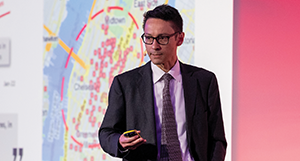 Nordal Cavadini, Oliver Wyman
Nordal Cavadini, Oliver Wyman
Dennis Schwedhelm, associate partner, McKinsey & Company, presented “The Future of Mobility,” plus “Connecting Driver and Retailer in an Autonomous-Driving World.”
Retail, convenience and mobility are all mixed in the same ecosystem now, he said. “A lot of this is driven in cities and by cities, and you need to think about it in an integrated way because it changes how, when and where you interact with your customers.” The how is what retailers should look to influence, he advised.
Scooters, e-bikes, ride-hailing and car-sharing as efforts “all try to reduce congestion and use of cars in cities,” and Paris is Schwedhelm’s favorite example of the changing face of mobility. The French capital has cut vehicle traffic by 30% over the past 15 years and plans to cut greenhouse gas emissions from vehicles by 40% by 2030, including a plan to ban diesel cars by 2024 and gasoline-powered vehicles by 2030. All city streets will have bicycle lanes by 2024, and intermodal forms of transit will be widely available.
He cited the 15-minute-city concept that would allow residents to reach their daily destinations via a 15-minute walk or bicycle ride. It’s hard work, he said, but Paris is committed to the change. “Other cities will do the same,” he said. “The shift will look different in every city. ... It’s super local how the world is going to evolve, and you need to think superlocal in how you act on that.”
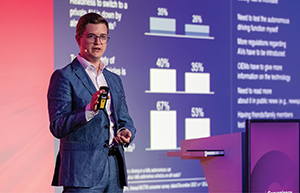 Dennis Schwedhelm, McKinsey & Company
Dennis Schwedhelm, McKinsey & Company
Electrification is a shiny object. So are autonomous vehicles and connected vehicles and roadways. “When we look at the pace of the uptake in electrical vehicles, we’ve seen a tipping point. It’s not a concept anymore. It’s just a question of when and how fast we will move to all vehicles being electric.”
Adoption varies drastically, though, and part of that can be attributed to purchase subsidies and regulations. “If you buy an electric vehicle in Denmark or Norway, you get subsidies that are worth about half of that price point,” Schwedhelm said. Incentives in Germany and France are lower. “Don’t think of the electric vehicle as the one shiny object that’s going to happen overnight. It’s going to be very diverse. And fuel is not going to go away overnight, so you will need to find a concept that caters to both over the next 10 years of transition.”
Fully self-driving vehicles are still not here, and after years of hype, consumer interest in autonomous vehicles has slipped. “Consumers are not necessarily buying into this promise,” based on recent survey findings from McKinsey. For several years, consumer interest in autonomous vehicles was on the rise but “last year was the first time that responses actually dropped.” He attributes that shift to safety concerns in the wake of crashes involving Tesla models whose owners thought they could zone out while their car did the driving and also the confusing nomenclature for automated driving systems.
Once autonomous vehicles are available and gaining market share, the convenience retailing model will look “completely different because people don’t necessarily have to stop anywhere. They will sit in the car, and you need to interact with them in a different fashion.” He also touched on the lack of needed charging infrastructure. “It’s a huge bottleneck to build it out fast enough.” He sees the rise of destination charging that will become a community hub.
It’s super local how the world is going to evolve, and you need to think superlocal in how you act on that.
A NUANCED LOOK AT ESG
Adopting environmental, social and governance (ESG) initiatives just for the sake of looking good to shareholders or consumers doesn’t work. Instead, elements must be woven into a company’s DNA—which includes contributing to a greater social purpose but also making money. And companies need to tell their ESG story to their customers. These were some of the takeaways from the “ESG in Action—How to Get Value Out of It” session.
ESG has gained traction among corporations in recent years “when companies realized that they could make money by being environmentally responsible in their operations,” Armour said.
Three companies took the stage to focus on the three pillars of ESG, with overlapping approaches:
- Rafał Rudzki, ESG director, Żabka Polska, based in Warsaw, Poland, with about 7,000 convenience stores across the country.
- Murat Zengin, chief marketing officer, OPET, based in Istanbul, Turkey. OPET is the second-biggest fuel-oil distribution company in Turkey, with more than 1,300 stations under the brand of OPET and SUNPET.
- Stephen Hamilton, customer proposition director, Henderson Retail, Belfast, Northern Ireland. Henderson Retail is a division of Henderson Group, which owns and operates more than 95 SPAR and EUROSPAR stores in Northern Ireland.
In guiding the discussion, Armour said he sought to bridge the gap between those companies who aim to save the planet and those who aren’t yet concerned with ESG efforts.
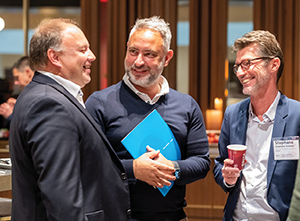 At Żabka, the crucial elements are “integrity, integration with the business and a strategy,” explained Rudzki. Żabka lives out its ESG purpose in multiple ways, Rudzki says. The Polish company strives to improve the quality of its private-label brands by scoring them for nutritional value, offering a selection of 100% plant-based food that caters to flexitarian lifestyles.
At Żabka, the crucial elements are “integrity, integration with the business and a strategy,” explained Rudzki. Żabka lives out its ESG purpose in multiple ways, Rudzki says. The Polish company strives to improve the quality of its private-label brands by scoring them for nutritional value, offering a selection of 100% plant-based food that caters to flexitarian lifestyles.
“On the other side when it comes to our franchisees (7,000 stores), we decided to phase out all unnecessary plastics,” Rudzki said, including disposable plastic bags. “Everything is certified paper-based items.” He said these simple things “change reality and help us to build that credibility” with customers.
Żabka runs internship programs for underprivileged youth that “show them that they can become in the future individual entrepreneurs,” Rudzki said. The program has a social purpose but also a business one in terms of training the next generation of potential c-store workers.
Rudzki said the privately owned company has a “great focus on culture and engagement of co-workers.” And “sharing the story with the public is quite important. In our case, we’ve been reporting ESG elements for a number of years. We are transparent in what we do. When we fail, we say that.”
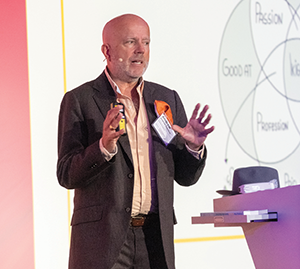 Andrew Thornton, Heart in Business
Andrew Thornton, Heart in Business
Zengin of Turkey’s OPET stressed the importance of sincerity and community investment when it comes to ESG efforts and then telling the story of your company’s social purpose. “Communication is crucial in every aspect, especially in ESG,” Zengin said.
The publicly traded company was founded by two high school teachers 30 years ago. “So, our way of governance is teaching,” Zengin said. “We make our people believe our values. We teach our consumers about who we are and why we do what we do.”
OPET doesn’t lose sight of the fact that it’s an oil company. “We are not a charity organization,” Zengin said. “It’s not bad to be a charity, of course, but they are two different things.” Companies need to be profitable in order to invest money to effect change in society. “We are in business to make money, not save the world,” he said.
“You must invest in your business, so the business grows, people work, they feed, they travel, people prosper, the environment will change, the society will grow.” At the same time, “we believe in what we do, and we do it sincerely,” Zengin said. “We are a very strong values-driven company and get results for our business.”
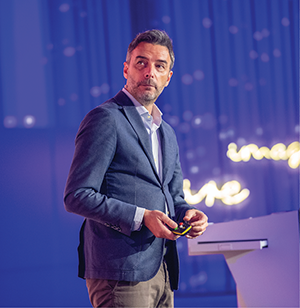 Jordi Rua Gonzalez, Microsoft, Italy
Jordi Rua Gonzalez, Microsoft, Italy
An important part of OPET’s community investment is empowering women in Turkey, especially the women who work in the company’s stores. “We are empowering women because it’s a huge social problem all over the world and in Turkey. We are doing it for the sake of the women, but in the stations in the service areas that women work, our income is 4% higher. You understand what it means in terms of income in the oil business, but that way we can invest more and more to change the culture. Companies should earn and contribute to society.”
Henderson Retail is just starting out on its ESG journey, Hamilton said. In its stores, Henderson uses 100% renewable energy across its portfolio, including energy from solar and wind turbines. “It’s an initiative that’s part of ESG, but it’s also a commercially sensitive thing to do,” shared Hamilton.
We are in the business to make money, not save the world.
Fresh food is a linchpin of the brand’s proposition. “Seventy-five percent of our fresh foods are sourced in the island of Ireland,” Hamilton said. “It’s a good message.” Henderson is a family-owned business, which believes in “doing the right thing for the right reasons.” The company’s stores don’t sell alcohol or lottery services.
One corporate goal is to increase sales of better-for-you products, Hamilton explained, and the other is decarbonization. “This is how you can tell the story to the financial community,” he said. “Another focus area and strategy is to help our customers lead a more sustainable life,” part of which is expanding its physical store assortment and digital offer.
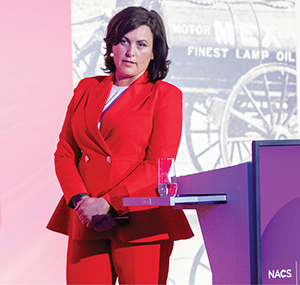 Siobhán Grimes, Maxol Group
Siobhán Grimes, Maxol Group
PLANNING FOR THE FUTURE
Convenience Summit Europe attendees also heard from several speakers on critical industry topics:
- Victor Paterno, president and CEO,7-Eleven, Philippines, shared an update of convenience retail in Asia, where labor is less of an issue, in “Future Dimensions of the Convenience Offer.”
- Armour moderate a discussion on “Where Is the Future Happening in C-Retail in Europe?” featuring panelists Carol Chen, global CMO and senior vice president electromobility, Shell; Anne-Laure Gex-Plettner, global group growth formats director, Carrefour; and Anna Grabowski, executive vice president and chief commercial officer, Żabka Polska.
- “Winning the Future,” featured a conversation between Armour and Jesper Østergaard, CEO, Reitan Denmark.
- A panel discussion with the 2021 Convenience Retail Award winners led by Director of NACS Europe Mark Wohltmann included Hans-Olav Høidahl, executive vice president Europe, Circle K Norway, winner of the 2021 Technology Award; Frank Ellingjord-Dale, sustainability manager, NorgesGruppen/SPAR Norway, winner of the 2021 Sustainability Award; and Brain Donaldson, CEO, Maxol Group, Ireland, winner of the 2021 Best of the Best Award.
- Berta Cabello Calvo,director of refining transformation, Repsol, presented “A Newfound Future for Liquid Fuels,” including a discussion of e-fuels.
- Jordi Rua Gonzalez, global director solution strategy—retail and consumer goods, Microsoft, Italy, presented “The Future of Technology and Its Impact on C-Retail.” The NACS European Convenience Retail awards gala reception and post-gala reception, both co-hosted by NielsenIQ, and the gala and awards, sponsored by The Coca-Cola Company, Dover and Gilbarco Veeder-Root, capped off the summit.